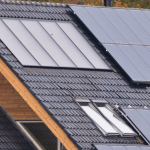
Even Downton Abbey is installing solar panels
Solar panels will be put up on much more unusual buildings after the Government relaxed planning restrictions, predicts a Midlands energy expert.
Ron Fox, of Noreus Ltd, said schools, churches, farm buildings and even Highclere Castle, the stately home which was the setting for ITV’s period drama Downton Abbey, were taking advantage of the changes.
Now only listed buildings or those in conservation areas will need permission to put the solar photovoltaic equipment on their roofs instead of those producing more than a four kilowatt peak.
Castle owner Lord Carnarvon has been given permission to put up a solar farm in his 1,000-acre grounds provided he puts up a native hedge to screen it from the nearby road.
It will bring the building where his family have been living since the 17th century into the 21st century with the installation of five huge glass-tilted panels which will allow the owners to generate their own electricity to power agricultural machinery.
There will be three rows of 50kW grounded mounted solar panels, two rows 150 feet long and the third half that size.
Highclere Castle in Berkshire is the setting for the fictional Downton Abbey, which is the Yorkshire country home of the Earl and Countess of Grantham and the series follows the lives of the aristocratic Crawley family and their servants during the reign of King George V in the early 20th century.
The TV drama, which has 11 million viewers in the UK and is now shown in 100 countries around the world, became so popular that it entered the Guinness Book of World Records in 2011 as the “most critically acclaimed English-language television show”.
“I am not surprised Lord Carnarvon is taking advantage of green technology to get cheaper electricity,” said Ron.
“Farms, churches and even schools can put 100 solar panels on a large building and receive smaller energy bills.”
He added: “Although some will have to pay 20% VAT on installing solar panels if they are VAT registered they will also be able to reclaim the full amount back.”
They may be able to claim a yearly capital allowance on the equipment for tax purposes.
But he said the main benefit was the Feed-in Tariff or FiT payment, which is the money the Government pays people for generating electricity every year from the scheme, which is index-linked to retail prices inflation and guaranteed for 25 years.
At present the FiT is paid at two tariffs. The Generation Tariff is at 21p per Kilowatt Hour for all electricity generated for a 4 KWP system and is topped up with the Export Tariff, which adds an extra 3.1p per KWh for electricity exported to the Grid.
But he warned that they would need to move quickly to take advantage of this as the Department of Energy and Climate Change (DECC) recently announced that the Feed-in Tariffs scheme would be reduced by almost a quarter from 21p to 16p per kilowatt hour (Kwh) from August 1.
At the same time it announced that it is shortening the lifespan of payments from 25 years to 20 years and will now consider cutting the payments even further every three months.
However, Ron said those who beat the deadline would be guaranteed those returns over 25 years and they would not lose out even if Feed-in Tariffs were cut in future.
For more details about how to take advantage of these energy-saving ideas call Ron on 01782 756995 or request a call back.



